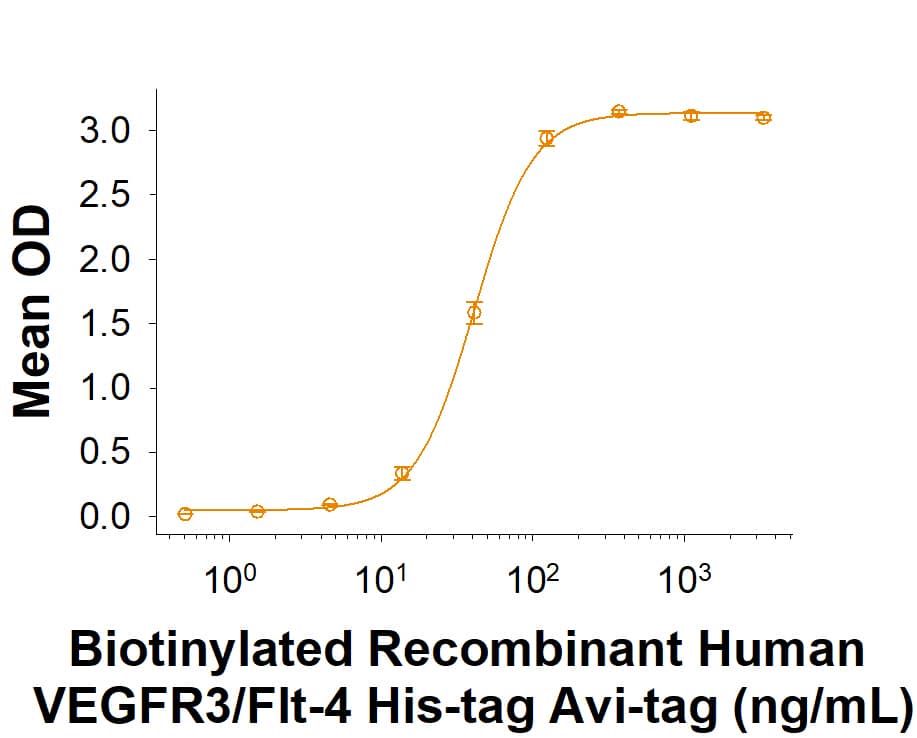Recombinant Human VEGFR3/Flt-4 His-tag Avi-tag Protein, CF
R&D Systems, part of Bio-Techne | Catalog # AVI10384

Key Product Details
Source
Accession #
Structure / Form
Conjugate
Applications
Product Specifications
Source
| Human VEGFR3/Flt-4 (Tyr25-Glu775) Accession # P35916.3 |
HHHHHH | Avi-tag |
| N-terminus | C-terminus |
Purity
Endotoxin Level
N-terminal Sequence Analysis
Predicted Molecular Mass
SDS-PAGE
Activity
Measured by its binding ability in a functional ELISA.
When Recombinant Human VEGF-C (Catalog # 9199-VC) is immobilized at 0.5 µg/mL (100 µL/well), Biotinylated Recombinant Human VEGFR3/Flt-4 His-tag Avi-tag (Catalog # AVI10384) binds with an ED50 of 15-90 ng/mL.
Scientific Data Images for Recombinant Human VEGFR3/Flt-4 His-tag Avi-tag Protein, CF
Biotinylated Recombinant Human VEGFR3/Flt-4 His-tag Avi-tag Protein Binding Activity
When Recombinant Human VEGF-C (Catalog # 9199-VC) is immobilized at 0.5 µg/mL (100 µL/well), Biotinylated Recombinant Human VEGFR3/Flt-4 His-tag Avi-tag (Catalog # AVI10384) binds with an ED50 of 15-90 ng/mL.Formulation, Preparation and Storage
AVI10384
| Formulation | Lyophilized from a 0.2 μm filtered solution in PBS with Trehalose. |
| Reconstitution | Reconstitute at 500 μg/mL in PBS. |
| Shipping | The product is shipped at ambient temperature. Upon receipt, store it immediately at the temperature recommended below. |
| Stability & Storage | Use a manual defrost freezer and avoid repeated freeze-thaw cycles.
|
Background: VEGFR3/Flt-4
VEGFR2 (KDR/Flk-1), VEGFR1 (Flt‑1) and VEGFR3 (Flt‑4) belong to the class III subfamily of receptor tyrosine kinases (RTKs). All three receptors contain seven immunoglobulin-like repeats in their extracellular domains and kinase insert domains in their intracellular regions. The expression of VEGFR1, 2, and 3 is almost exclusively restricted to the endothelial cells. These receptors are likely to play essential roles in vasculogenesis and angiogenesis. VEGFR3 cDNA encodes a 1298 amino acid (aa) residue precursor protein with a 24 aa residue signal peptide. Mature VEGFR3 is composed of a 751 aa residue extracellular domain, a 22 aa residue transmembrane domain and a 482 aa residue cytoplasmic domain. Both VEGF-C and VEGF-D have been shown to bind and activate VEGFR3 (Flt‑4). VEGFR3 is widely expressed in the early embryo but becomes restricted to lymphatic endothelia at later stages of development. It is likely that VEGFR3 may be important for lymph angiogenesis.
References
- Ferra, N. and R. Davis-Smyth (1997) Endocrine Reviews 18:4.
Long Name
Alternate Names
Gene Symbol
UniProt
Additional VEGFR3/Flt-4 Products
Product Documents for Recombinant Human VEGFR3/Flt-4 His-tag Avi-tag Protein, CF
Product Specific Notices for Recombinant Human VEGFR3/Flt-4 His-tag Avi-tag Protein, CF
For research use only
